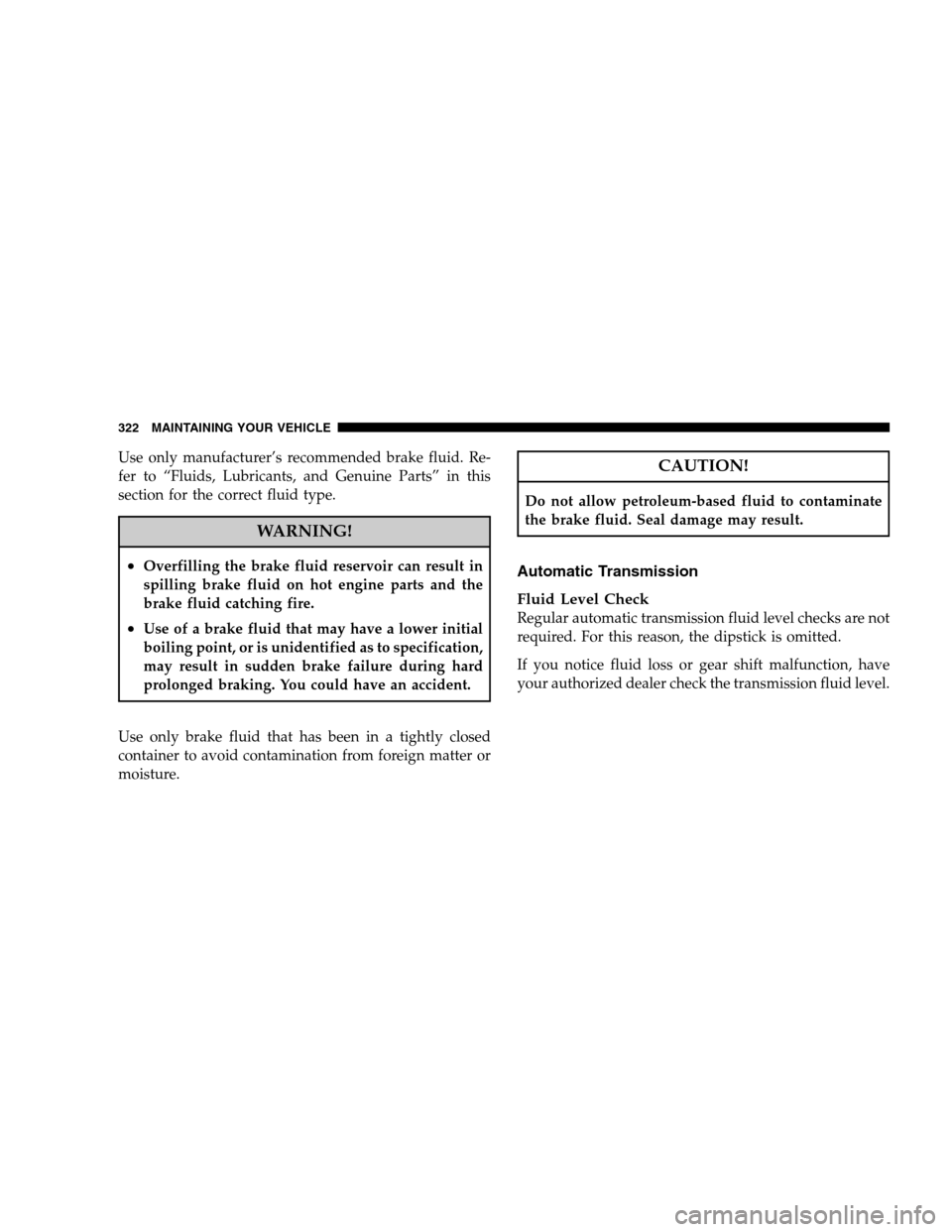Page 321 of 381

necessarily an indication of leakage. Actual dripping
of hot fluid when systems are under pressure (during
vehicle operation), should be noted before a hose is
replaced based on leakage.
•Inspect the brake hoses whenever the brake system is
serviced and at every engine oil change. Inspect hy-
draulic brake hoses for surface cracking, scuffing, or
worn spots. If there is any evidence of cracking,
scuffing, or worn spots, the hose should be replaced
immediately. Eventual deterioration of the hose can
take place resulting in a possibility of a burst failure.
WARNING!
Worn brake hoses can burst and cause brake failure.
You could have an accident. If you see any signs of
cracking, scuffing, or worn spots, have the brake
hoses replaced immediately.
Master Cylinder - Brake Fluid Level Check
Check the fluid level in the master cylinder immediately
if the brake system warning light indicates system fail-
ure.
Check the fluid level in the master cylinder when per-
forming underhood services.
Clean the top of the master cylinder area before removing
the cap. Add fluid to bring the level up to the top of the
“FULL” mark on the side of the master cylinder reservoir.
Overfilling of fluid is not recommended because it may
cause leaking in the system.
Add enough fluid to bring the level up to the require-
ments described on the brake fluid reservoir. With disc
brakes, fluid level can be expected to fall as the brake
pads wear. However, low fluid level may be caused by a
leak and a checkup may be needed.
MAINTAINING YOUR VEHICLE 321
7
Page 322 of 381

Use only manufacturer’s recommended brake fluid. Re-
fer to “Fluids, Lubricants, and Genuine Parts” in this
section for the correct fluid type.
WARNING!
•Overfilling the brake fluid reservoir can result in
spilling brake fluid on hot engine parts and the
brake fluid catching fire.
•Use of a brake fluid that may have a lower initial
boiling point, or is unidentified as to specification,
may result in sudden brake failure during hard
prolonged braking. You could have an accident.
Use only brake fluid that has been in a tightly closed
container to avoid contamination from foreign matter or
moisture.
CAUTION!
Do not allow petroleum-based fluid to contaminate
the brake fluid. Seal damage may result.
Automatic Transmission
Fluid Level Check
Regular automatic transmission fluid level checks are not
required. For this reason, the dipstick is omitted.
If you notice fluid loss or gear shift malfunction, have
your authorized dealer check the transmission fluid level.
322 MAINTAINING YOUR VEHICLE
Page 326 of 381

•If your vehicle is damaged due to an accident or
similar cause that destroys the paint and protective
coating, have your vehicle repaired as soon as pos-
sible. The cost of such repairs is considered the respon-
sibility of the owner.
•If you carry special cargo such as chemicals, fertilizers,
de-icer salt, etc., be sure that such materials are well
packaged and sealed.
•If a lot of driving is done on gravel roads, consider
mud or stone shields behind each wheel.
•Use MOPAR�Touch Up Paint or equivalent on
scratches as soon as possible. Your authorized dealer
has touch up paint to match the color of your vehicle.
Wheel and Wheel Trim Care
All wheels and wheel trim, especially aluminum and
chrome plated wheels should be cleaned regularly with a
mild soap and water to prevent corrosion. To removeheavy soil and/or excessive brake dust, use MOPAR�
Wheel Cleaner (05066247AB) or equivalent or select a
nonabrasive, non-acidic cleaner. Do not use scouring
pads, steel wool, a bristle brush, or metal polishes. Only
MOPAR�or equivalent is recommended. Do not use
oven cleaner. Avoid automatic car washes that use acidic
solutions or harsh brushes that may damage the wheels’
protective finish.
Interior Care
Use MOPAR�Fabric Cleaner or equivalent to clean fabric
upholstery and MOPAR�Carpet Cleaner for carpeting.
Interior Trim should be cleaned starting with a damp
cloth, or MOPAR�Satin Select. Do not use harsh cleaners
or Armorall. Use MOPAR�Total Clean to clean vinyl
upholstery.
MOPAR�Total Clean is specifically recommended for
leather upholstery.
326 MAINTAINING YOUR VEHICLE
Page 330 of 381
CavityCartridge
FuseMini-
FuseDescription
1 — 15 Amp
BlueWasher Motor
2 — 25 Amp
NeutralPowertrain Control Mod-
ule (PCM)
3 — 25 Amp
NeutralIgnition Run/Start
4 — 25 Amp
NeutralEGR Solenoid/Alternator
5— ——
6 — 25 Amp
NeutralIgnition Coils/Injectors
7— ——
8 — 25 Amp
NeutralStarter
9— ——
10 30 Amp
Pink— Windshield WiperCavityCartridge
FuseMini-
FuseDescription
11 30 Amp
Pink— Anti-Lock Brake System
(ABS) Valves
12 40 Amp
Green— Radiator Fan Lo/High
13 50 Amp
Red— Anti-Lock Brake System
(ABS) Pump Motor
14 — — —
15 50 Amp
Red— Radiator Fan
16 — — —
17 — — —
18 — — —
19 — — —
20 — — —
21 — — —
22 — — —
330 MAINTAINING YOUR VEHICLE
Page 343 of 381
Chassis
Component Fluids, Lubricants, and Genuine Parts
Automatic Transmission MOPAR�ATF+4 Automatic Transmission Fluid
Brake Master Cylinder MOPAR�DOT 3, SAE J1703 should be used. If DOT 3, SAE J1703 brake
fluid is not available, then DOT 4 is acceptable. Use only recommended
brake fluids.
Power Steering Reservoir MOPAR�Power Steering Fluid + 4, MOPAR�ATF+4 Automatic Transmis-
sion Fluid
Rear Axle API GL-5 SAE 75W140 Synthetic Gear Lubricant or equivalent
MAINTAINING YOUR VEHICLE 343
7
Page 347 of 381

•Change your engine oil more often if you drive your
vehicle for an extended period of time.
•Under no circumstances should oil change intervals
exceed 6,000 mi (10 000 km) or six months, whichever
comes first.
Your authorized dealer will reset the oil change indicator
message after completing the scheduled oil change. If this
scheduled oil change is performed by someone other
than your authorized dealer, the message can be reset by
referring to the steps described under “Oil Change
Required” under “Electronic Vehicle Information Center
(EVIC)” in Section 4.
At Each Stop for Fuel
•Check the engine oil level. Refer to “Engine Oil” under
“Maintenance Procedures” in Section 7.
•Check the windshield washer solvent and add if
required.Once a Month
•Check tire pressure and look for unusual wear or
damage.
•Inspect the battery, and clean and tighten the terminals
as required.
•Check the fluid levels of coolant reservoir and brake
master cylinder, and add as needed.
•Check all lights and other electrical items for correct
operation.
At Each Oil Change
•Change the engine oil filter.
•Inspect the brake hoses and lines.
CAUTION!
Failure to perform the required maintenance items
may result in damage to the vehicle.
MAINTENANCE SCHEDULES 347
8
M
A
I
N
T
E
N
A
N
C
E
S
C
H
E
D
U
L
E
S
Page 348 of 381
Required Maintenance Intervals
Perform Maintenance Every(Where time and mileage
are listed, follow the interval that occurs first.)
Maintenance Items Miles Kilometers or Months
Change the engine oil and engine oil filter. 6,000 10 000 6
Rotate the tires. 6,000 10 000 6
If using your vehicle in dusty or off-road conditions,
inspect the engine air cleaner filter, and replace if nec-
essary.12,000 20 000 12
Inspect the brake linings, and replace if necessary. 12,000 20 000 12
Replace the air conditioning filter (if equipped). 12,000 20 000 12
Inspect the rear axle fluid. 18,000 30 000 18
Inspect the CV joints. Perform the first inspection at
12,000 mi (20 000 km) or 12 months.24,000 40 000 24
Inspect the exhaust system. Perform the first inspec-
tion at 12,000 mi (20 000 km) or 12 months.24,000 40 000 24
Inspect the front suspension, tie rod ends and boot
seals, and replace if necessary.24,000 40 000 24
348 MAINTENANCE SCHEDULES
8
M
A
I
N
T
E
N
A
N
C
E
S
C
H
E
D
U
L
E
S
Page 362 of 381

About Your Brakes.................... 232,234
ABS (Anti-Lock Brake System) ............235,238
Adding Engine Coolant (Antifreeze) .......... 316
Adding Fuel ........................... 274
Adding Washer Fluid .................. 124,312
Additives, Fuel ......................... 272
Air Cleaner, Engine (Engine Air Cleaner Filter) . . . 304
Air Conditioner Maintenance ............... 309
Air Conditioning ........................ 203
Air Conditioning Controls ................. 203
Air Conditioning Filter .................208,310
Air Conditioning, Operating Tips ............ 209
Air Conditioning Refrigerant .............309,310
Air Conditioning System ................203,309
Air Pressure, Tires .................... 156,255
Airbag ................................ 46
Airbag Deployment ..................... 51,53
Airbag Light ..................... 52,55,70,152
Airbag Maintenance ....................... 55 Airbag, Side
.......................... 47,53
Airbag, Window (Side Curtain) .............47,53
Alarm, Panic ............................ 25
Alarm (Security Alarm) .................18,156
Alarm System (Security Alarm) ............... 18
Alignment and Balance ................... 261
Alterations/Modifications, Vehicle ............. 7
Antenna, Satellite Radio ................... 196
Antifreeze (Engine Coolant) ...........315,316,341
Disposal ............................ 317
Anti-Lock Brake System (ABS) ............235,238
Anti-Lock Warning Light ...............158,236
Anti-Theft Security Alarm (Theft Alarm) ........ 18
Anti-Theft System ....................... 156
Appearance Care ........................ 324
Arming Theft System (Security Alarm) ......... 18
Assistance Towing ........................ 91
Audio Systems (Radio) .................... 191
Auto Down Power Windows ................ 34
362 INDEX